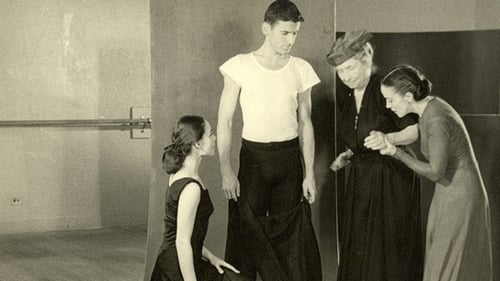The Horse with the Flying Tail (1960)
The fabulous true story of a jump-happy cowpony that sailed to glory with a wave of his golden tail!
Gênero : Documentário
Runtime : 48M
Director : Larry Lansburgh
Sinopse
A palimino cow pony, through a series of owners and adventures becomes a champion mount for one of the US equestrian team.

Narrated by actress Katharine Cornell and filmed in black and white, it spends the first 24 minutes introducing viewers, through newsreels, interviews, and old photographs, to the story of the deaf and blind disabled-rights pioneer. News footage shows her international appearances and visits with heads of state, including President Eisenhower allowing her to feel his face. The second half takes a day-in-the-(exceptional)-life approach to Keller's existence circa 1955. Made just 13 years before her death, Keller's famed tutor-translator-friend Anne Sullivan had already died, leaving her live-in replacement, Polly Thomson, to share the film's focus. From the time Keller takes her morning walk along the 1,000-foot handrail around her yard through her workday to her nightly reading of her Braille Bible, her serene acceptance of her life will amaze and inspire.

Moody, atmospheric ghost story starring Mason as a retired tradesman who purchases an old mansion that has been vacant for 40 years because it is believed to be haunted by the spirit of a young woman who had died there. Unaware of the mansion's reputation, Mason and his wife Mullen move in and hire a young woman, Lockwood, to keep house. Soon after Lockwood's arrival, strange things begin to happen in the household, and it becomes apparent that she is possessed by the spirit of the dead girl, though Mason scoffs at the idea. On death's door and bedridden, Lockwood asks for the same doctor who treated the woman who died 40 years ago. He arrives and treats her. The next morning Lockwood is cured, and it is revealed by the police that the doctor's dead body was found in his carriage hours before the time Mason claims he arrived to see Lockwood. Convinced that not only the ghost of the girl but that of the doctor as well entered his home, Mason finally believes in the supernatural.

Princeton: A Search for Answers is a 1973 American short documentary film, directed by Julian Krainin and DeWitt Sage, and produced for the Princeton University Undergraduate Admissions Office as a recruiting film. In 1974, it won the Academy Award for Best Documentary (Short Subject) at the 46th Academy Awards.

On May 8th, 1945, writer, director Norman Corwin broadcast ON A NOTE OF TRIUMPH, an unforgettable homage to the end of war in Europe. This film shines a light on a lost work of genius, and examines it's haunting resonance to today's current events.

In September, 1959, six Europeans leave Cook's Bay on the southern coast of Dutch New Guinea, now West Papua or Irian Jaya, to trek north to the far side of the island. The journey (450 miles, as a crow flies) across unmapped territory took seven months; three Muyu porters died. Near both coasts, the expedition met villagers who invited them to observe rituals and live with them. In the interior, all villagers kept them at bay, and they depended on air lifts from Hollandia for food and supplies. They climbed above 10,000 feet, built 14 bridges, and fought leeches and malaria. The narrator focuses on describing Stone Age savages, headhunters, and cannibals.

An African tribe in the Eastern Nigerian village of Umana work to build a maternity hospital, with the aid of government officials, and against the opposition of some tribal members.

An unflinching verité portrait of the children of Stanton Elementary School in North Philadelphia, an inner-city neighborhood where 90% of the students live below the poverty line. Seen through the viewpoint of devoted principal Deanna Burney, the film shows Stanton as grossly underfunded, understaffed, and filled with children struggling to overcome their difficulties. But for these at-risk kids, however, the hope for their future survives only in the success of their education. A captivating series of vignettes concerning children growing up outside the American dream, echoing current “hot-button” issues in our country’s ongoing political discussion.

A young boy's successful battle against cancer and his subsequent efforts to help other children overcome their fears of the illness.

"To Be Alive!" was designed to celebrate the common ground between different cultures by tracing how children in various parts of the world mature into adulthood.

This 1991 Academy Award®-winning documentary uncovers the disastrous health and environmental side effects caused by the production of nuclear materials by the General Electric Corporation.

The story of a boy who has a goldfish as a pet, and the family cat has other plans for the goldfish, and a canary protects it by distracting the cat.

Oscar Winning short documentary

Oscar Winning documentary short about Charlie Clements, a Vietnam War pilot who was convinced by his experiences in the war that he should become a doctor working behind enemy lines.

This Academy Award winning short subject documentary follows the United States Coast Guard icebreaker ships Eastwind and Westwind for four months as they work to clear navigational paths for ships traversing the arctic sea.

Angel and Big Joe is a 1975 American short drama film directed by Bert Salzman and starring Paul Sorvino and Dadi Pinero. It tells the story of a friendship between a migrant boy and an electrician who has greater ambitions. The film won an Oscar at the 48th Academy Awards in 1976 for Best Short Subject.

The short drama film follows the daily life of the Juan and Jorge, two brothers living on the streets of Mexico City. It won an Academy Award in 2001 for Best Live Action Short Film.

The O'Dell farm is on the rocks. A non-traditional accountant comes with a variety of ways to save the farm.

A look at some of the last stone carvers working in the United States, those completing the sculptures adorning the Washington National Cathedral. They discuss their craft and the cultural forces which helped define it, as well as the fading use of stone ornamentation in architecture and the history of stone carving, and they tour the cathedral to point out the history behind some of the work.

This biographical docudrama traces the life of Dr. Albert Schweitzer, from his birth in Alsace, up to the age of 30 when he made the decision to go to French Equatorial Africa and build his jungle hospital. The latter half of the film encompasses a full day in the hospital-village, following the octogenarian Samaritan in his daily rounds.







